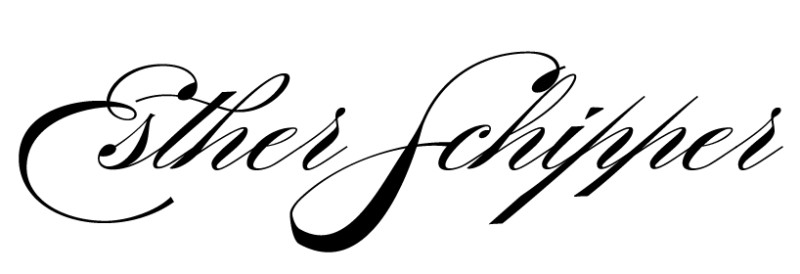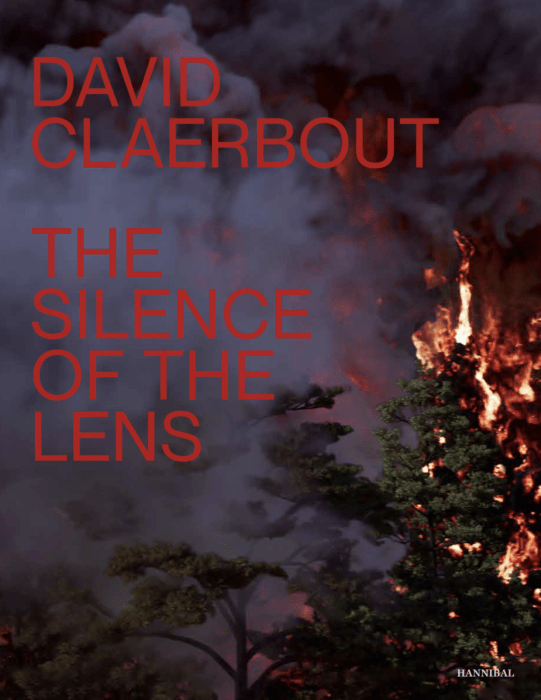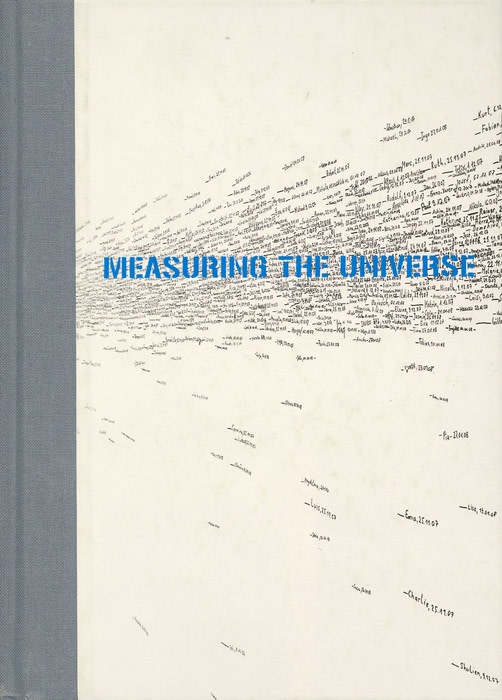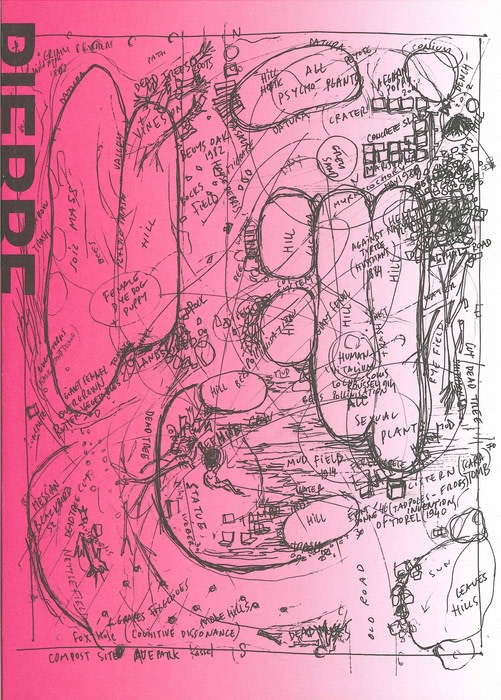Willkommen: Hier finden Sie die deutsche Fassung des Briefes aus Berlin
Welcome to this month's Letter from Berlin! We begin with Angela Bulloch's major solo exhibition in Nantes and publish excerpts from the artist's conversation with the exhibition's curator, Katell Jeffrès. In Berlin, David Claerbout's exhibition continues through May 28. For his new monograph, he spoke with curator Jonathan Pouthier. We revisit last year's L'Invitation au voyage and look at the work of Sojourner Truth Parsons. Two fairs are currently on: Frieze NY and Taipei Dangdai, while next week Art Basel Hong Kong opens. On Sunday a film by Rosa Barba will be screened at the Jeu de Paume in Paris. It is also the last day of the group exhibition Fata Morgana with works by Ann Veronica Janssens and Daniel Steegmann Mangrané. We look ahead to two upcoming projects by Pierre Huyghe, in Denmark and in Norway. In Munich, Roman Ondak's performative work Measuring the Universe which will be enacted at the Pinakothek der Moderne beginning June 3. Listen to the recent podcast with Esther Schipper, from Daniela Steinfeld's Voices on Art series. Finally, we close with a selection of new and recent publications. We hope you enjoy our Letter from Berlin!
|
|
|
Angela Bulloch, Perpendicular Paradigm – Musée d'Arts de Nantes |
|

| Exhibition view: Angela Bulloch, Perpendicular Paradigm, Musée d'Arts de Nantes, 2022. Photo: Cécile Clos
| |
|
Under the title Perpendicular Paradigm, Angela Bulloch's major solo exhibition of new and recent work just opened at the Musée d’arts de Nantes. Reconstructing the constellations in the starry sky above the museum at the 2021 summer solstice, the artist has installed Firmamental Square, a monumental Night Sky work, in the museum's atrium. Geometric sculptures made of wood, metal or synthetic marble populate the exhibition spaces along with their shadow wall paintings. In addition, a new two–channel video animation presents a 3D version of the very exhibition on view, showing a slice of a meta-reality, an exhibition within the exhibition with two invented characters roaming the exhibition; one is apparently human and the other is a planetary system made up of elements of the artist's work.
Perpendicular Paradigm was curated by Katell Jaffrès and will be on view through August 30, 2022.
Below we publish excerpts from a conversation between Bulloch and Jaffrès featured in the comprehensive exhibition catalogue which also will include a new essay by Mieke Bal. The catalogue is forthcoming in June.
|
|
|
Angela Bulloch in conversation with Katell Jaffrès
|
|
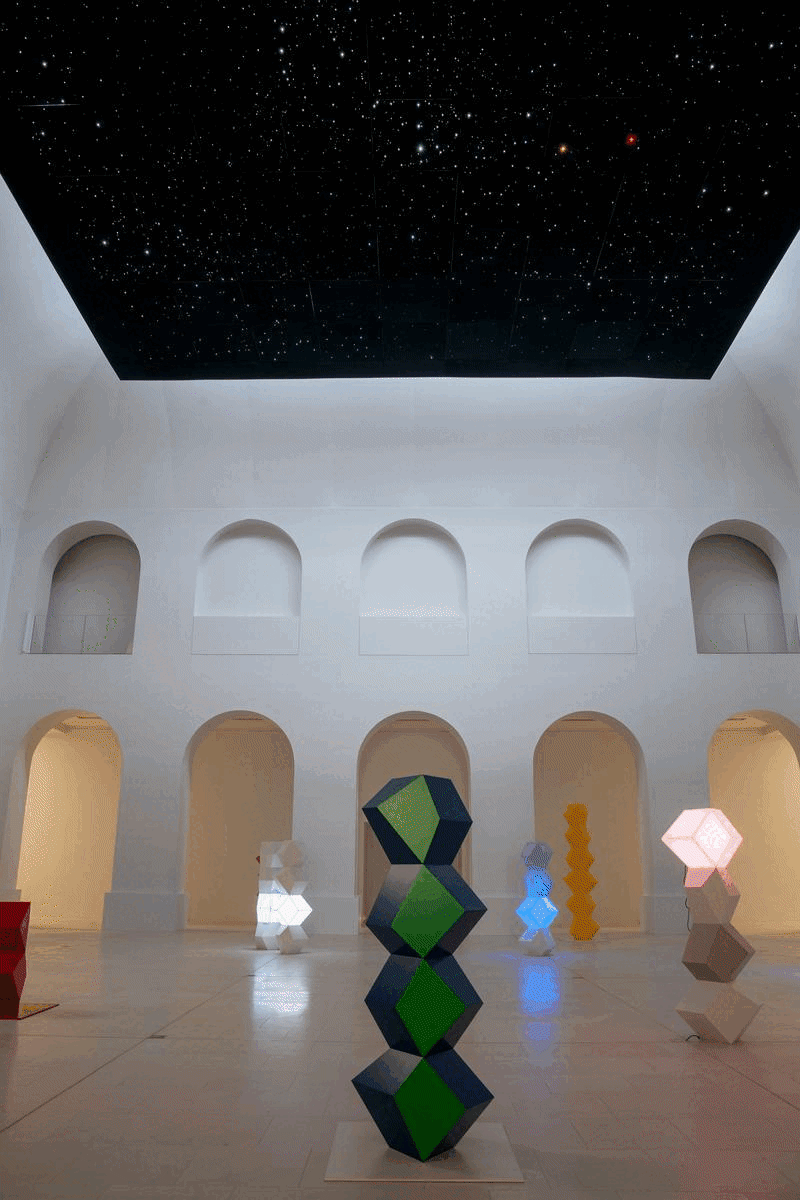
| Exhibition views: Angela Bulloch, Perpendicular Paradigm, Musée d'Arts de Nantes, 2022. Photos: Cécile Clos | |
|
KATELL JAFFRÈS
The large new work, Firmamental Square, consists of a 14 x 14 meters Night Sky hanging from the ceiling of the Atrium. You have made several Night Sky works before, including a few very large ones which hung from a ceiling. Most of these works were smaller and were installed vertically on the wall. Where does the concept of this work series come from, and how do the works relate to each other?
ANGELA BULLOCH
The first work in the series was Night Sky: E.T. from Mercury.12 made in 2007. The E.T. in the title refers to an “Extra Terrestrial position” using a software that is a virtual Universe, or a 3D space-scape or a 3D map. To look at the relative positions of Earth within our planetary system and the universe beyond that, I have taken a snap shot looking back at Earth and framed a 2 dimensional area from inside the 3 dimensional virtual map that shows our planet – I could see the Earth from more or less the position of Mercury. This work was first placed on the ceiling but later it was adapted to be hung on the wall together with a reflecting plane perpendicular to it on the floor.
My first large-scale work form the series was exhibited as part of “theanyspacewhatever” exhibition held at the Solomon R. Guggenheim Museum in New York in 2008 featuring my work and the work of my contemporaries. I chose the occasion of that exhibition and specifically the rotunda of the Solomon R. Guggenheim Museum by Frank Lloyd Wright as the strong architectural context to present the first large scale Night sky. The rotunda in New York could be made to look like the ceiling of the Pantheon in Rome with an oculus window open to the sky at night. Later, I produced another work to hang above the altar in the Cathedral in Basel which is another example of a ‘strong context’ I have chosen to place this type of work within.
The date of the summer solstice June 21st 2021 was the moment I chose to capture an image of the positions of the stars in the sky to produce the work Firmamental Square. It is from this date, and from a position in the sky above Nantes, France that I have defined, captured, cropped and recorded to use that particular view as the ceiling backdrop of my exhibition. Using an accurate computer mapping of the universe, I captured all the relative positions of the visible stars within that view and produced a new work with that information. (…)
|
|
|
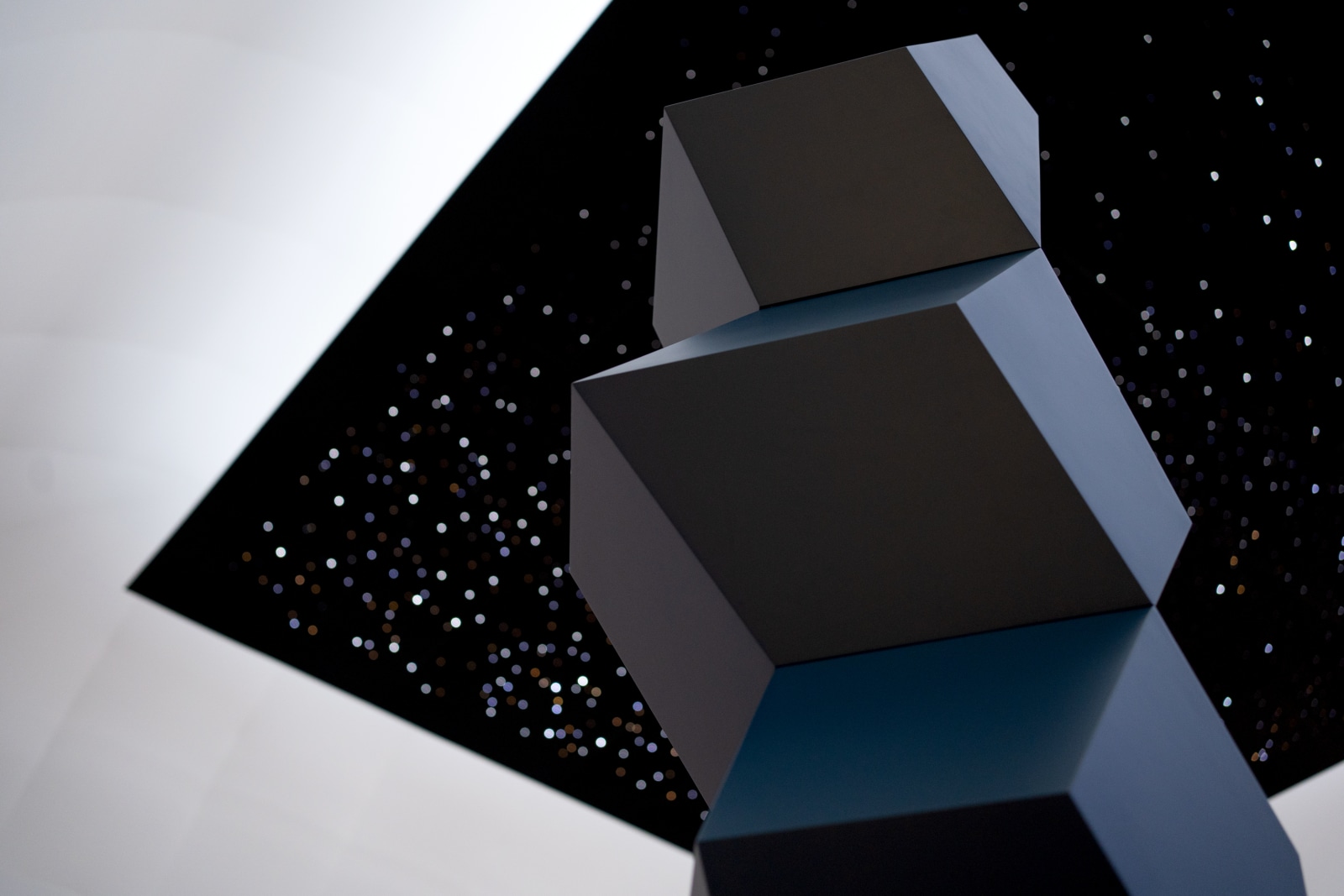
| Exhibition view: Angela Bulloch, Perpendicular Paradigm, Musée d'Arts de Nantes, 2022. Photo: Cécile Clos | |
|
KJ
Perception, through colours and light which are at the core of the works, is an important aspect of your work. How do you relate your work to it?
AB
Perception requires at least some viewers to witness and participate with that context or situation, so, in other words, perception engages the audience to witness and to participate. Therefore I have added to the work - people perceiving the work, as a part of the work. I also want to consider the deconstruction of perception and representation as elements of the work. I have produced an exhibition that has wall paintings, sculptures, installation works and I have included the audience to see those works or to engage with that exhibition, as part of the exhibition.
One work is titled We don’t know what we don’t know. I have chosen this enigmatic title so that we don’t forget about the elements that we either don’t understand or that we literally just can’t see. Those things that are beyond comprehension or more literally beyond our vision or sight are nonetheless still very much present. Like Dark Matter, we know that it exists even though we don’t “see” it.
|
|
|

| Video stills: Angela Bulloch, Perpendicular Paradigm, 2022, two-channel video. 3D Technical Services by Bertrand Flanet. © the artist
| |
|
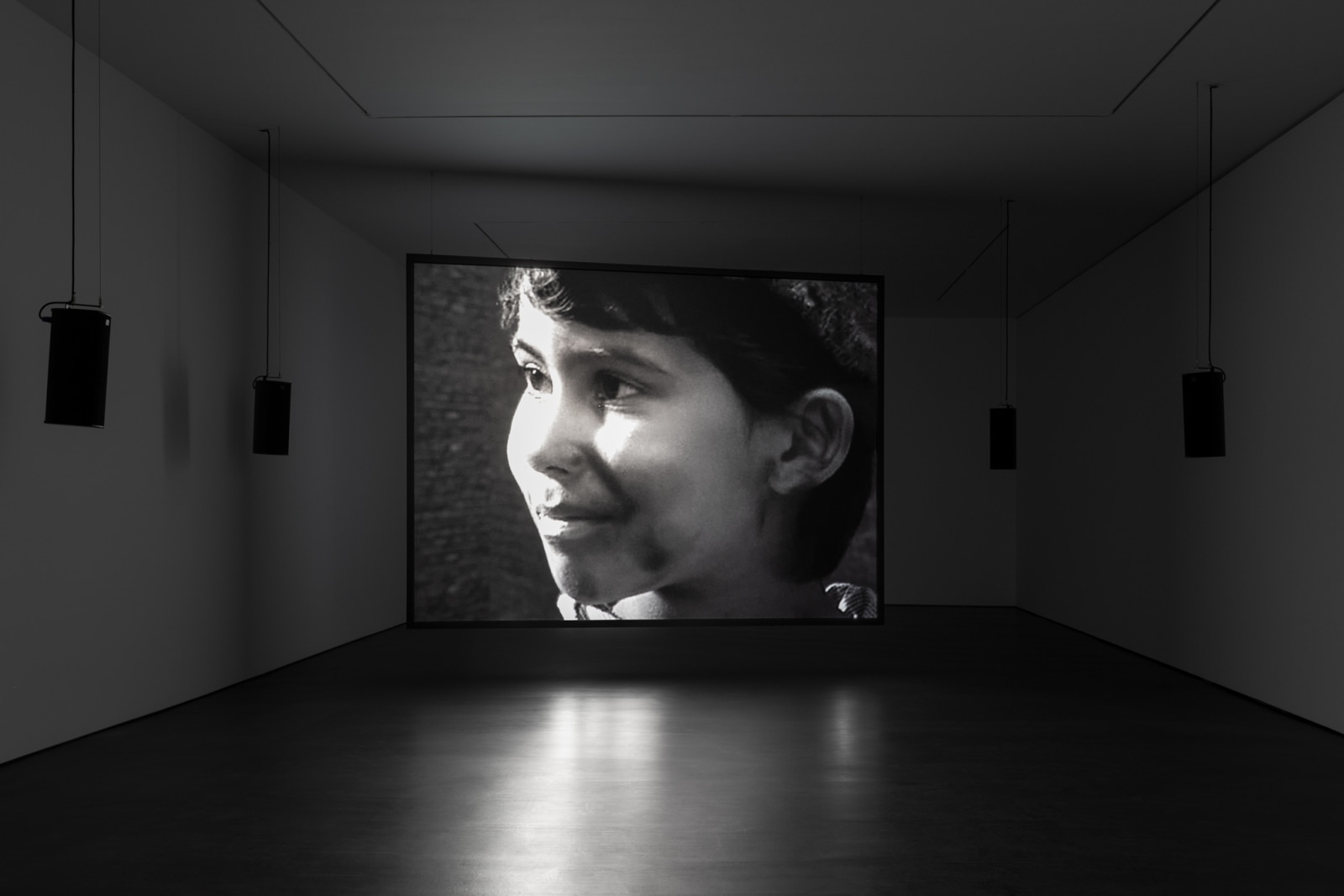
| David Claerbout, The Close, 2022, single channel video projection, black & white, 6 channel surround sound, duration: 15:00 min.
Exhibition view: David Claerbout, Hemispheres, Esther Schipper, Berlin, 2022
© VG Bild-Kunst, Bonn, 2022. Photo © Andrea Rossetti
| |
|
David Claerbout's new monograph, The Silence of the Lens, includes extensive conversations between Jonathan Pouthier with the artist. Below are excerpts on The Close and Aircraft (F.A.L.)
Personally, I have always seen myself as someone who catches the debris on the fringes of an explosive visual culture. —David Claerbout
The Close
JONATHAN POUTHIER
It is at the moment when the illusion is perfect that you decide to reveal the artificiality of the composition. How does this clash of two antagonistic regimes of belief in images invite us to question our gaze?
DAVID CLAERBOUT
This transition from an under-defined image to a hyper-defined one occurs at the end of the film. After a long freeze, the camera lens slowly moves towards the face of a child. Their expression is frozen in time. We have the impression that the film has stopped, that the projection is glitching. This moment of rupture is necessary for the camera to continue its course and lose itself in the child's gaze. Their immobile body, as though frozen in the moment, then appears on the screen like a sculpture. It is nothing but texture, surface and volume. It is at this precise moment that a clearing opens up between the mechanism of trust and that of distrust. It is no longer a question of dissociating the real from the fake, but of finding where the act of looking is located.
If the virtual teaches us anything, it is that we find ourselves with this technology between these two states. Jean-Luc Nancy explained that "regarder c'est garder deux fois." Looking implies the desire to preserve something, to incorporate it. Becoming the other is the index of empathy. So the child's eyes appear to me as the place of this encounter. It is through their mediation that we can determine our degree of trust and distrust and that we can measure distance or proximity. It is also to preserve a certain simplicity that I decided to focus attention on the eyes. They have a greater capacity to reach our nerves than any other appearance. We have to ask ourselves what looking implies when faced with an image whose foundations are crumbling. Should we remain on our guard, be wary of what we see? Or, on the contrary, does looking require the loss of our gaze? For the citizens of the nineteenth century, the emergence of the camera certainly questioned their gaze in a similar way. Now it is our turn to find ourselves in a new transition in our system of trust. |
|
|
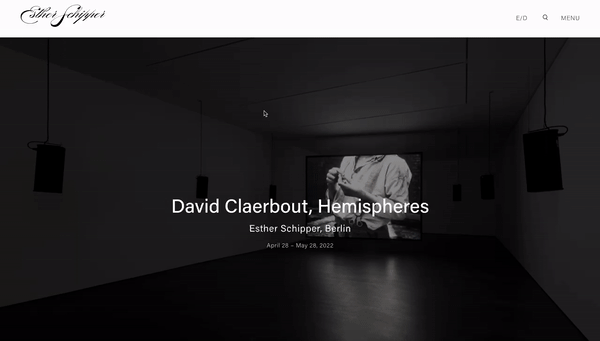
| Experience the Online Viewing Room here
| |
|
Aircraft (F.A.L.)
JP
To begin with, I would like to discuss the aeroplane that makes up the motif and main subject of your piece. In his essay Down to Earth: Politics in the New Climatic Regime, Bruno Latour wonders 'where to land?' when industrialised societies keep denying the consequences of their lifestyles on climate change. The aeroplane in Aircraft (F.A.L.), on the other hand, remains immobile, as though unable to fly. Why does this symbol of industrial modernity remain grounded?
DC
This metaphor allowed me to illustrate my work method for the production of this piece, but also my concerns about the nature of the image. The materiality of the virtual image has always interested me because we have always thought that this type of image was, by definition, incompatible with the very idea of matter. I, however, have had the sense that it constitutes something quite real and present. The way in which materials are determined by a complex set of data conditioned my research throughout the making of this film. For example, the aluminium surface that envelops the structure of the aeroplane shows no trace or sign of use. This detail becomes apparent, in fact, when the camera approaches the wings. The immobility of the aeroplane is a deliberate choice. Unlike any other machine of the industrial age, the aeroplane is an object that is considered to be in motion, even when it is static. Its nature is defined by its relationship with the airflow.
The aeroplane in my film is not actually on the ground. It rests on a scaffold in a scene that is both improvised and organised. I sometimes think that, on the screen, it looks like a sarcophagus. This regime of indistinction between what is alive and what is inert, between what could be used and what is no longer usable, constitutes the dramatic subtext of the composition. This may seem paradoxical because in our culture the aeroplane symbolises a certain conception of progress. Its shape is similar to that of an arrow pointing permanently forward like an index of the future. It draws a line at the end of which everything would be led to move forward. I was invested in the idea of confronting this progressive thought with these materials that have been frozen for a long time, such as light, concrete, wood and metal. |
|
|

| Watch now – David Claerbout discusses his practice and works in his exhibition at Esther Schipper.
Film by ArtBeats
| |
|
JP
This aeroplane transposed into a reflective surface seems to take on the optical functions of the camera lens. How does this object, this vision machine, show and inform us about the nature of the image?
DC
All this is conditioned by the positioning and movements of the camera in a defined space. When the presence of the camera operator is perceptible, or when the point of view is the same as that of the characters in the image, this reflection of the body towards the outside is made difficult or even impossible. The situation is that of an eye/lens placed randomly, or not. As soon as we enter the world of scanning, we realise that the gaze turns around the object. It is a position that can be described as egotistical insofar as everything constantly turns around the same centre. I see this as a fundamental difference between scanning and the lens. It is possible to move the camera anywhere, yet it cannot be anything other than a lens in a given world. In this, the camera is profoundly liberal, like the time of its development. It is free to move and does not seek to know what appears before its lens. By contrast, scanning reverses our relationship with the world because we become the centre of it and are surrounded by obstacles. This situation is quite similar to the way some video game software works. That is to say, the world we see is created only temporarily according to our needs and our bodily proximity. That is probably why I set the aeroplane at the centre of the composition.
|
|
|

| Gallery Weekend Berlin ask David Claerbout the question "Are memories the key for future?" in their 'A Coffee With...' series, produced by Gallery Weekend Berlin and BMW. | |
|

| Left: Sojourner Truth Parsons, Falling out of love with you, 2020-2021, acrylic on canvas, 213,2 x 182 x 3,8 cm
Right: Sojourner Truth Parsons, July Tree, 2020-2021, signed and dated verso, acrylic on canvas, 213,5 x 183 x 4 cm. Exhibition view: L'Invitation au voyage, Esther Schipper, Berlin, 2021. Photo © Andrea Rossetti
| |
|
A year ago Esther Schipper presented L’Invitation au voyage, a group exhibition spanning multiple generations and artistic approaches, inspired, influenced, and expanding on representations of dream and fantasy.
Beginning with pioneering avant-gardist Hannah Höch, and established figures such as Paula Rego, Almut Heise, Leiko Ikemura, and Yeesookyung, the exhibition continued into the practices of younger generations with works by Sarah Buckner, Cui Jie, Cordula Ditz, Tala Madani, Isa Melsheimer, Sojourner Truth Parsons, Shahzia Sikander, and Tsai Yi-Ting.
One room was dedicated to the paintings of Sarah Buckner and Sojourner Truth Parsons.
Born in Vancouver, Canada, in 1984, Sojourner Truth Parsons is an artist of Afro-Indigenous and settler heritage. She holds a Bachelor of Fine Arts from Nova Scotia College of Art and Design, Halifax, Nova Scotia. The artist lives and works in Brooklyn, NY.
|
|
|
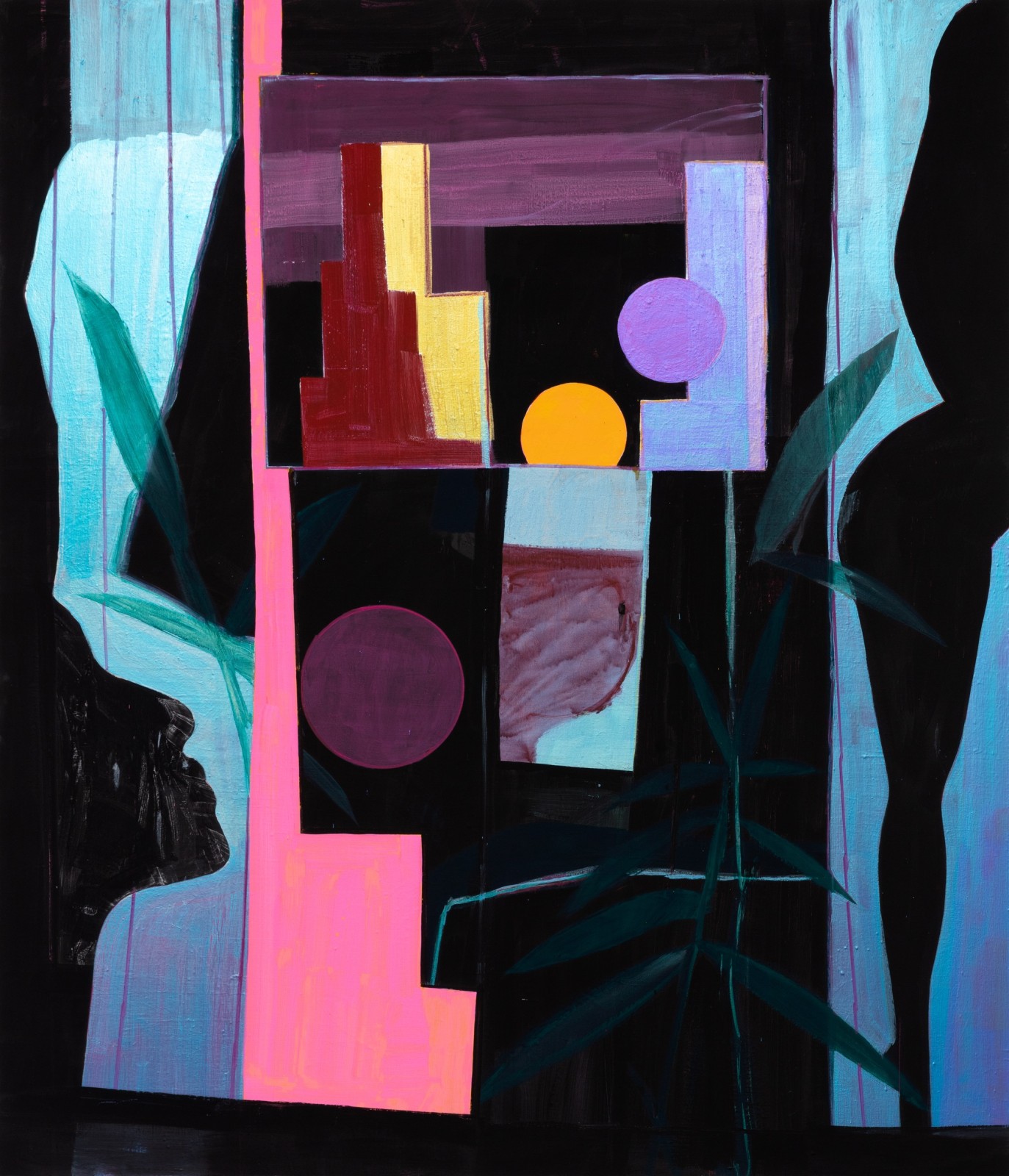
| Sojourner Truth Parsons, July Tree, 2020-2021, acrylic on canvas, 213,5 x 183 x 4 cm
© Sojourner Truth Parsons. Photo © Andrea Rossetti
| |
|
About Parson's works Matthew Hyland, who had curated the artist's solo exhibition at The Oakville Galleries in Ontario a few years back, wrote the following:
In L’Invitation au voyage, Parsons presents a suite of canvases grounded in darkness. Shadows stretch languidly across the surface of these works, with loosely brushed expanses of black suggesting the cover of nightfall, when thresholds between sense and sensation are at their gauziest. Here, Parsons offers a city imaged in fragments—the mirrored surface of the Manhattan skyline at dusk, moonlight playing on the East River—scenes drawn as readily from the artist’s frequent wanderings near her Brooklyn studio as from the New York of her mind’s eye, one conjured at least in part from relic.
(....)
The moon anchors these compositions, repeating bright and full across all three canvases, their central figures seemingly tethered to its transportive energies: desire, fantasy, introspection, risk. In July Tree, two women appear in silhouette, a recurring motif in Parsons’ work, one that casts the body as both energy and form. A neck arched in pleasure, a lithe figure extending outside the frame—these are shadowy, sharp-edged presences, as elusive as they are compelling. Amidst their charge sits the suggestion of the city at night, its structures and rhythms, the fullness of its promises and potency of its perils.
In Falling out of love with you, this tension comes into sharper focus, a gowned and gloved figure—noirishly stylized, the very projection of desire—gazing across the harbor toward Manhattan, a single long-stemmed rose in hand. Looser, prosaic florals flank the image, set against crude patchworks of blushes and golds. These arrangements puncture the shield of night, suggesting a scene about to end, the veil of illusion giving way to other forms of beauty—perhaps less precise in their elegance, but awaiting us regardless.
—excerpt from Matthew Hyland, "Sojourner Truth Parsons," L'Invitation au voyage, published by Esther Schipper, 2021. Ordering information below
|
|
|

|
L'Invitation au voyage with texts by Gayatri Gopinath, Karoline Hille, Matthew Hyland, Marco Livingstone, Isabelle Moffat, Tobias Peper, Andy St. Louis, Wenny Teo, Marie-Catherine Vogt, Wim Wenders, and Chung Wei-Tzu, 2021 Publisher: Esther Schipper. Language: English © Esther Schipper Available here
| |
|
Parson's 2017 solo exhibition at the Oakville Galleries in Ontario, entitled Holding Your Dog At Night, had brought together a series of canvases produced by the artist after relocating to Los Angeles in 2015.
Whether detailing the city's infamous nightlife, its extraordinary sunlight or the economic disparities on which it is built, Parsons' works offer a kind of baroscopic depiction of the spaces and places she moves through, at once ingenuous and acerbic. Neither autobiographical nor narrative in form, the paintings instead nudge us toward the psychic life of the everyday, to the feelings, forms and fantasies—both saccharine and sinister—that structure our worlds.
|
|
|
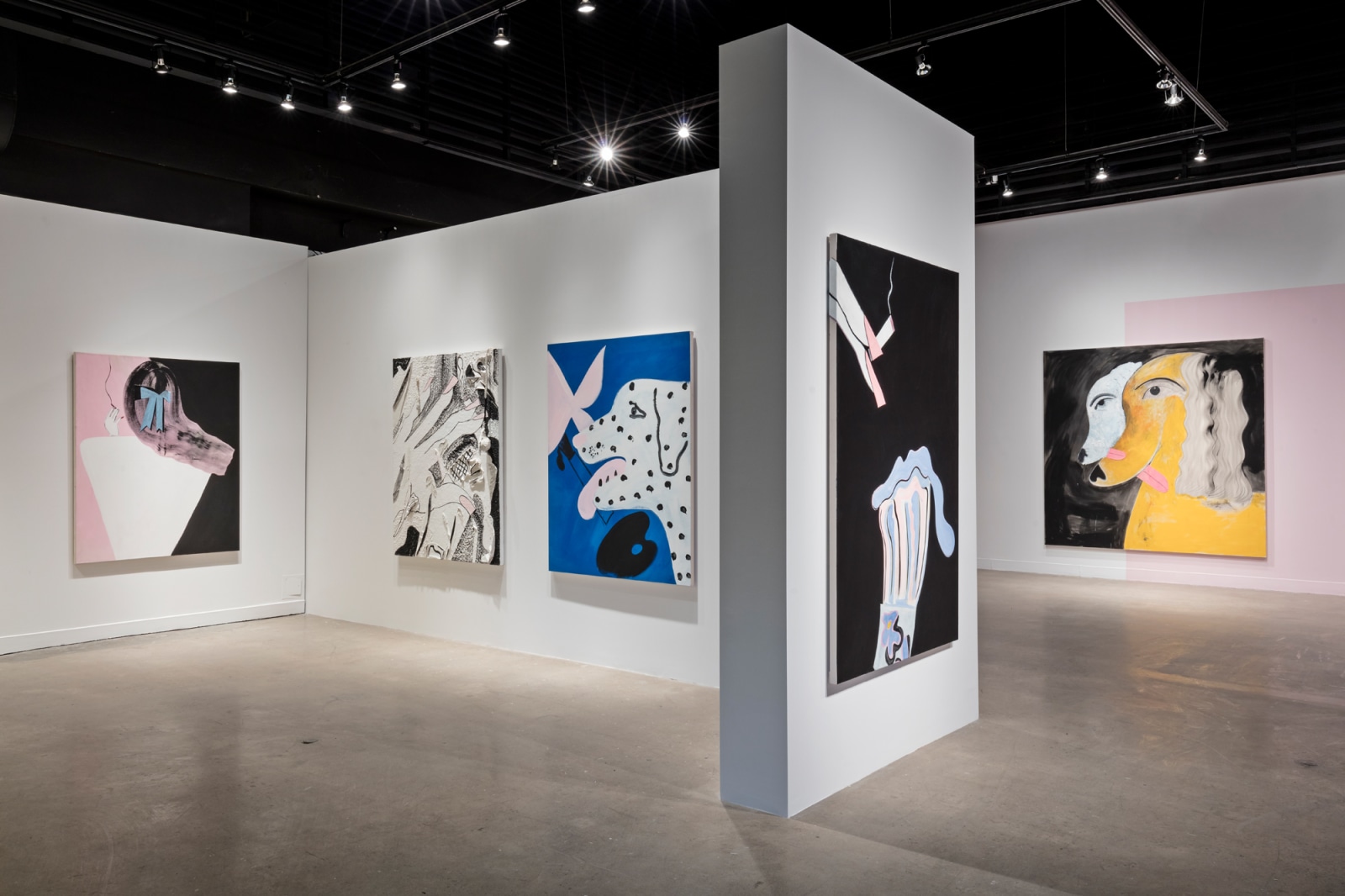
| Exhibition view: Sojourner Truth Parsons, Holding Your Dog At Night, Oakville Galleries, Oakville, 2017.
Photo © Toni Hafkenscheid
| |
|
Simon Fujiwara – Frieze New York 2022
|
|
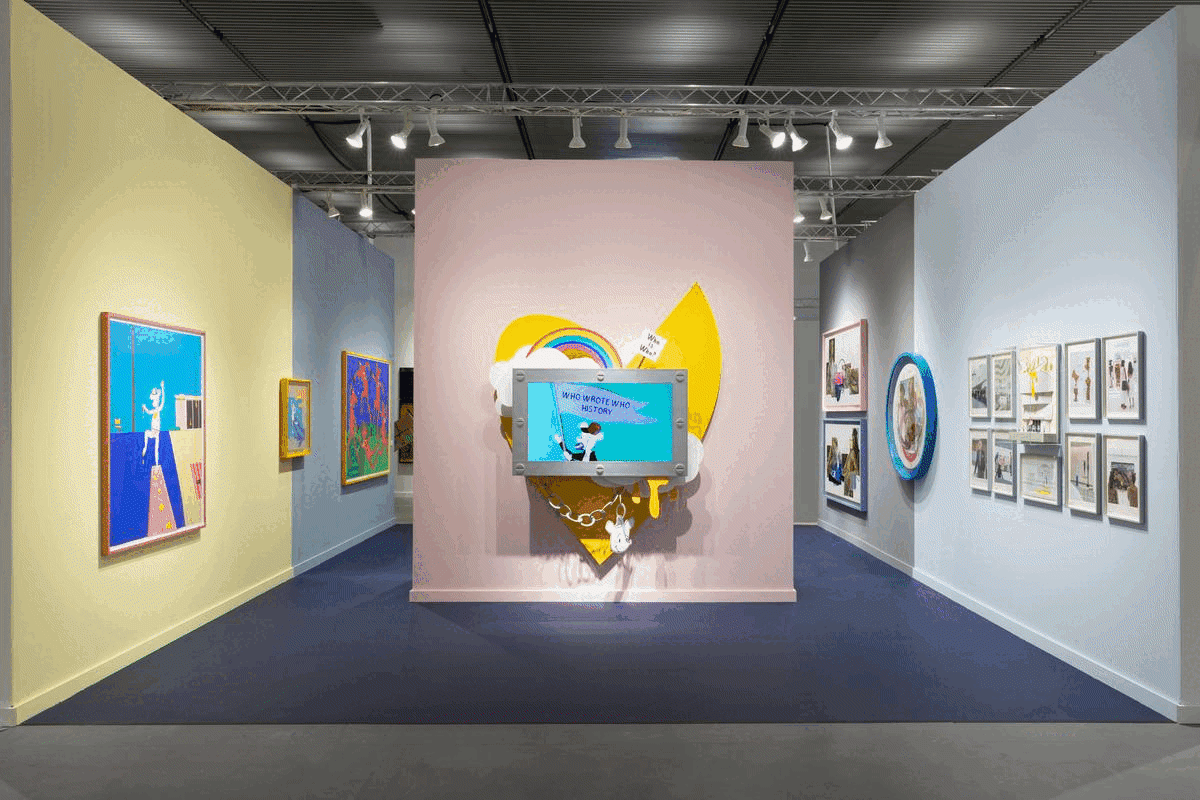
| Booth views: Esther Schipper, Frieze New York, 2022. Photos © Sebastiano Pellion di Persano
| |
|
Frieze New York 2022
Booth A06 The Shed 545 West 30th Street New York, NY 10001 May 18 – 22, 2022 www.frieze.comPreview: May 19 Public Days: May 20 – 22 Online Viewing Room and 3D BoothThrough May 27 Join us this week at Frieze New York where we present present a solo booth with Simon Fujiwara, dedicated to his body of work, Who the Bær, which premiered in his 2021 solo exhibitions at Fondazione Prada, Milan; and at Esther Schipper in January 2022. On view are multiple new works from Fujiwara's Who the Bær project presented in a highly inventive range of media ranging from collage, drawing, painting and sculpture to stop-motion animation. Staged within an exhibition design with themed rooms with differently colored walls, the booth presentation will resemble a museum, or “Whoseum,” featuring iconic works that reference and remix modern and contemporary artists: from Renaissance paintings by Jan van Eyck, Sandro Botticelli and Michelangelo, to iconic works from the 20th century artistic cannon. All are Who-ified, so to speak, i.e. given the characteristic silhouette of Who.
|
|
|
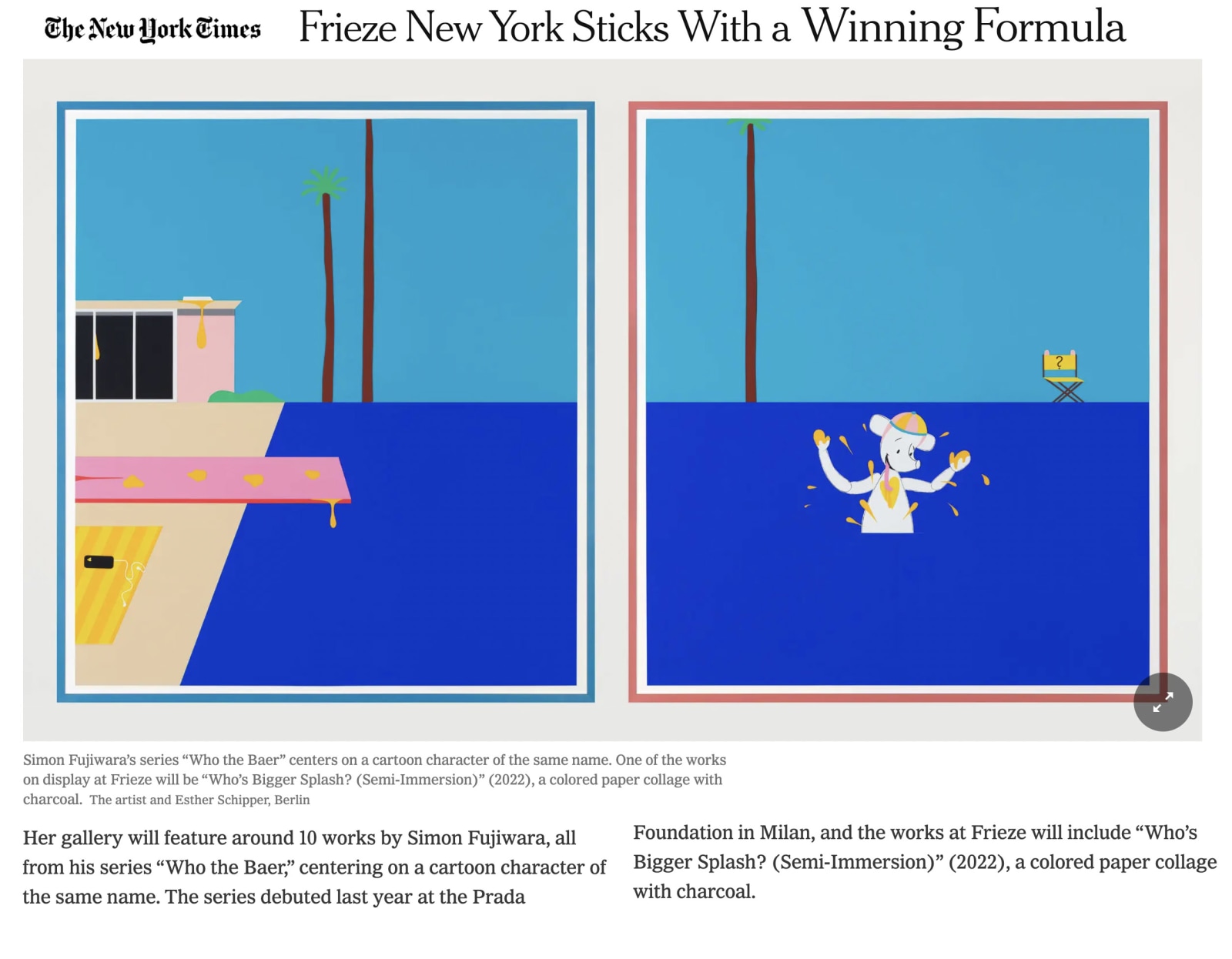
| Read the New York Times on Frieze New York here
| |
|

| Booth view: Esther Schipper, Taipei Dangdai 2022. Photo © Chong Kok Yew | |
|
Taipei Dangdai 2022
Booth C05 Taipei World Trade Center No. 5 Section 5, Xinyi Rd Xinyi District, Taipei City Through May 22, 2022 www.taipeidangdai.comJoin us at Taipei Dangdai 2022 where we present works by: AA Bronson, Thomas Demand, Simon Fujiwara, General Idea, Liam Gillick, Dominique Gonzalez-Foerster, Ann Veronica Janssens, Ugo Rondinone and Karin Sander
Please also visit the online platform of Taipei Dangdai – Art & Ideas 2022 to discover a selection of works presented at the fair. Read here (CN) – Leslie Sun, Editor-in-Chief, Vogue Taiwan, highlights Esther Schipper as a must-see at Taipei Dangdai 2022. If you wish to receive a dossier, or should you have any questions about our presentation at Taipei Dangdai 2022, please contact Muchi Shaw: shaw@estherschipper.com
|
|
|
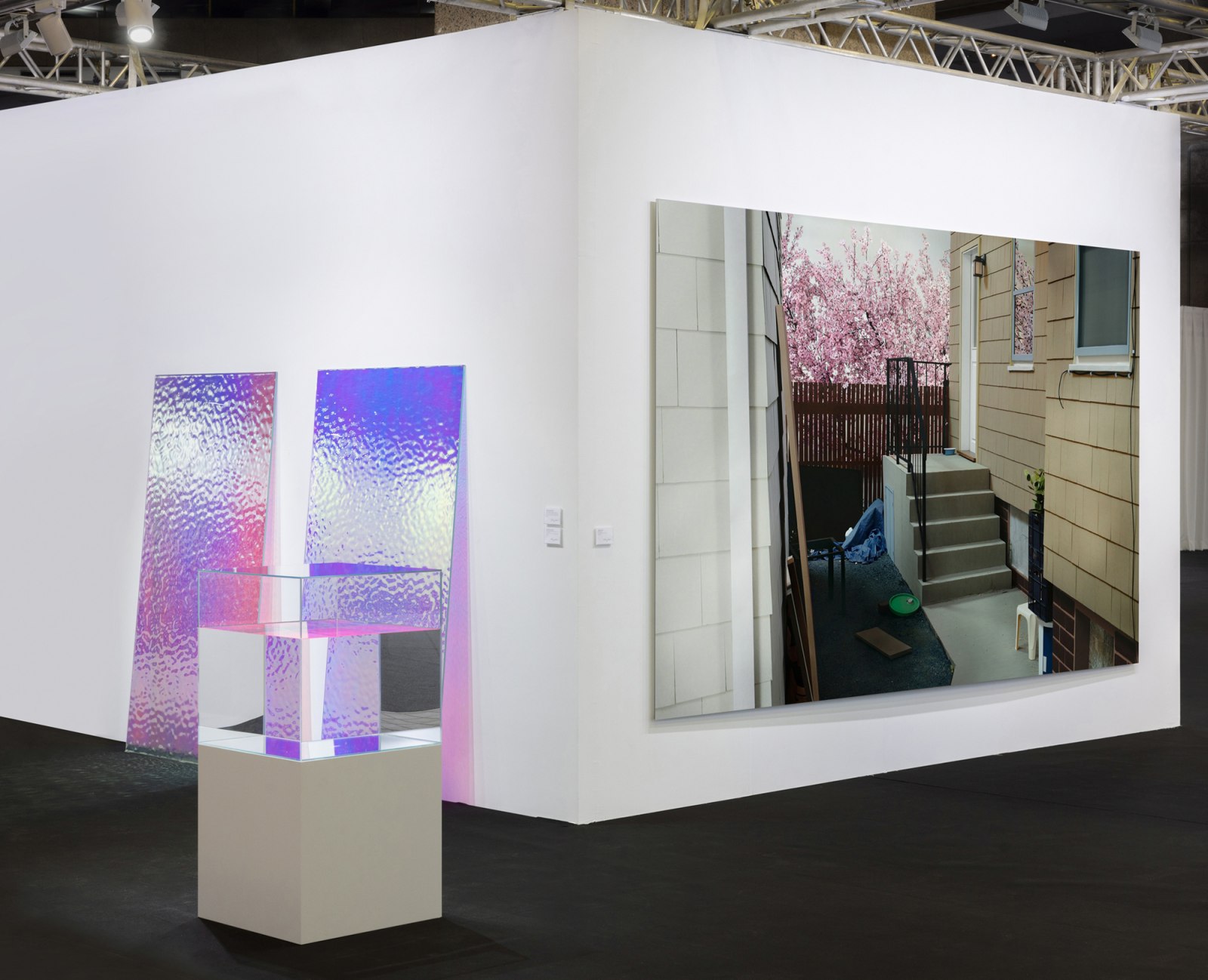
| Left, wall: Ann Veronica Janssens, frisson bleu, frisson rose, 2021, hammered glass laminated on dichroic PVC film and float glass, 200 x 110 x 1 cm, each (2 parts). © the artist / VG Bild-Kunst, Bonn, 2022
Left, in the foreground: Ann Veronica Janssens, Pink Coco Lopez, 2010-2018, glass, paraffin oil, serigraph, wooden base, 60 x 60 x 60 cm (vitrine), 60 x 60 x 60 cm (base), 120 x 60 x 60 cm (overall). © the artist / VG Bild-Kunst, Bonn, 2022
Right, wall: Thomas Demand, Backyard, 2014, C-Print / Diasec, 230 x 382 cm. © the artist / VG Bild-Kunst, Bonn, 2022.
Booth view: Esther Schipper, Taipei Dangdai 2022. Photo © Chong Kok Yew | |
|

| Gradient grey silk paintings by Matti Braun (130 x 100 cm each).
Sculptures by Angela Bulloch (MDF or synthetic marble sheet material, 150 x 40 x 40 cm; 150 x 50 x 30 cm).
Photos © Andrea Rossetti | |
|
Art Basel Hong Kong Booth 1B14 Convention & Exhibition Centre 1 Harbour Road, Wan Chai Hong Kong Preview: May 25-26, 12pm - 8pm, May 27-28, 12pm - 2pm Public Days: May 27-28, 2pm - 8pm www.estherschipper.comVisit us next week Art Basel Hong Kong 2022 opens. Our booth will feature a presentation of works by Matti Braun and Angela Bulloch. We also invite you to discover a complete overview of works presented at the booth on Art Basel Hong Kong's the online platform. If you wish to receive a preview dossier, or should you have any questions about our presentation at Art Basel Hong Kong 2022, please contact Marek Obara: obara@estherschipper.com
|
|
|
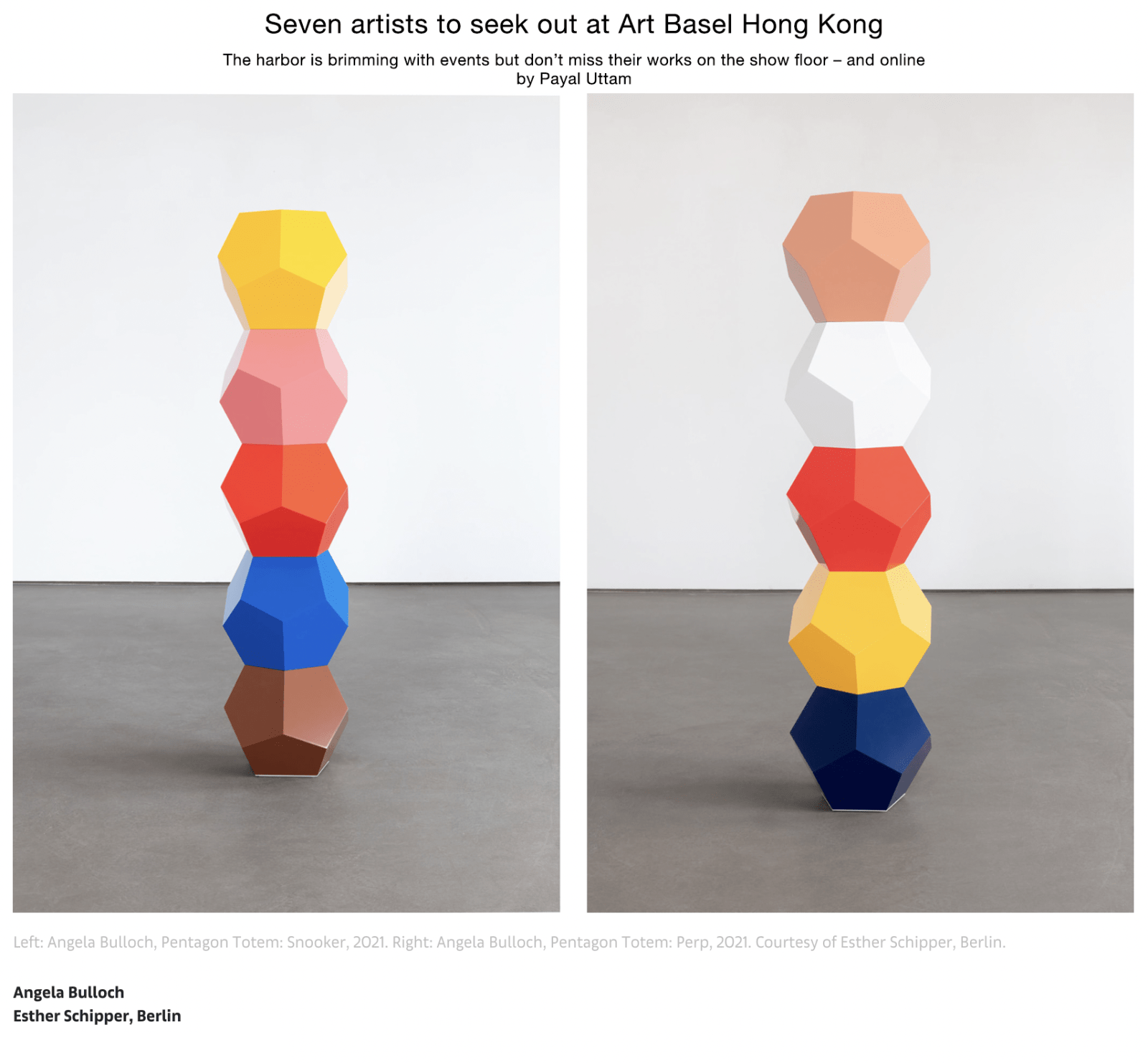
| Read Art Basel, 'Seven artists to seek out at Art Basel Hong Kong' here
| |
|
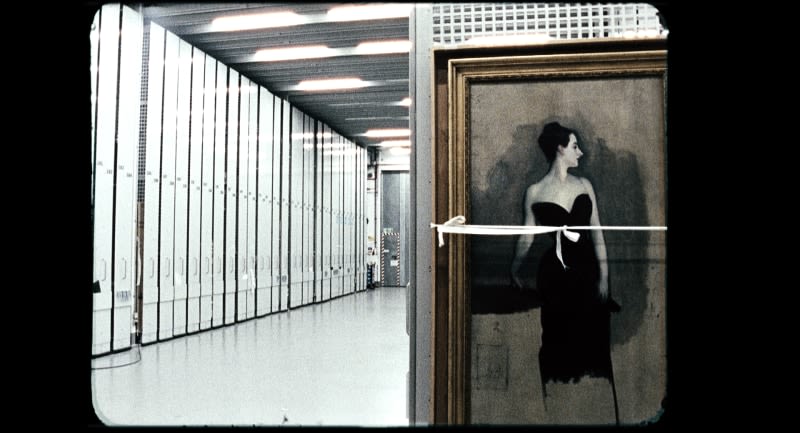
| Still: Rosa Barba, The Hidden Conference: About the Shelf and Mantel, 2015, 35-mm film, color, optical sound, 14 min. © Rosa Barba, VG-Bild Kunst, Bonn 2022 | |
|
Screening Fata Morgana Rosa Barba, The Hidden Conference: About the Shelf and Mantel, 2015 Jeu de Paume 1 Place de la Concorde Jardin des Tuileries 75001 Paris May 22, 2022, 4pm www.jeudepaume.orgDon't miss the screening of Rosa Barba's The Hidden Conference: About the Shelf and the Mantel at the Jeu de Paume. May 22 is also the last day to see the exhibition, Fata Morgana which includes works by Ann Veronica Janssens and Daniel Steegmann Mangrané. Fata Morgana, the first edition of the Jeu de Paume festival, occupies the entire building and was curated by the independent curator Béatrice Gross, with the artistic advice of Katinka Bock. The title refers to the exceptional phenomenon caused by the combination of mirages on the surface of the sea, whose refractions make suspended images of objects located below the horizon appear: it is therefore the singular sensitive realities conveyed by the contemporary image that the curators have chosen to explore. Fata Morgana is a critical and poetic reflection on the concrete ways in which the visible appears, which is often more unstable and ambiguous than it seems. The multidisciplinary exhibition brings together, alongside photographs, films and video installations, sculptures, performances and sound pieces. It is a certain quality of attention to the sensitive world – rather than a theme, a movement or a generation – that is proposed. The title refers less to the trompe-l’oeil effect than to the learning of the eye, between wonder and deciphering.
|
|
|
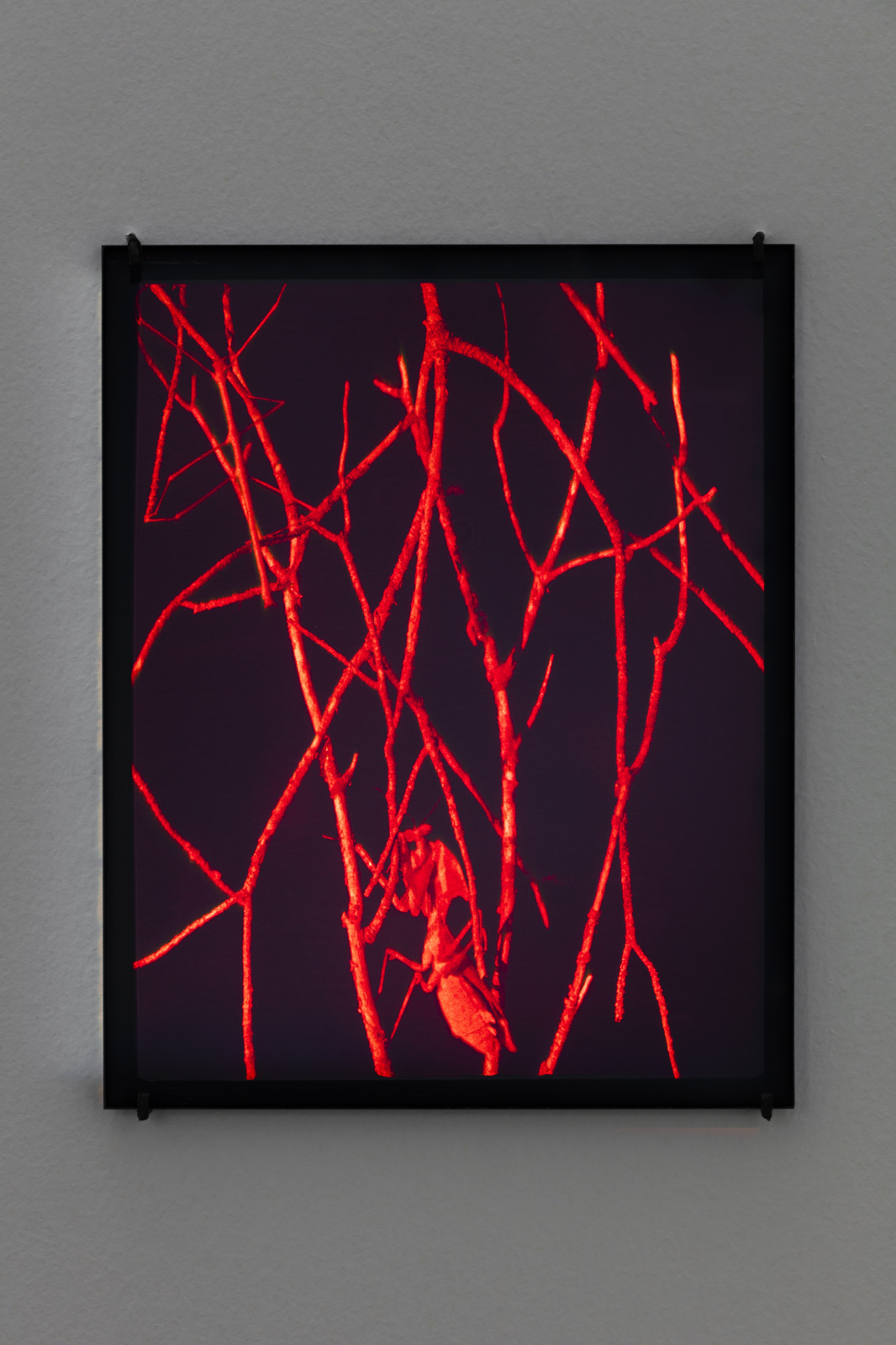
| Daniel Steegmann Mangrané, Hologram (Thicket), 2021, pulse hologram, 25 x 20 cm (9 7/8 x 7 7/8 in). Photo © Andrea Rossetti | |
|

| Still: Pierre Huyghe, De-Extinction, 2014, film, color, stereo sound, 12 min. 38 sec. © the artist | |
|
Pierre Huyghe
Offspring
Kunsten Museum of Modern Art Kong Christians Allé 509000 Aalborg May 25 – October 30, 2022 www.kunsten.dkA solo presentation by Pierre Huyghe opens next w eek at the Kunsten Museum in Aalborg, Denmark. The exhibition will be on view through October 30, 2022. In Huyghe’s contingent universe, diverse intelligent life forms – biotic and abiotic – evolving indeterminately, produce continuous changes in their environments. The works are dynamic and modify over time, often exceeding the artist's control. For Huyghe the exhibition is not merely a site for viewer experience, but rather an encounter with an immersive, sentient milieu, that perceives, generates new possibilities of alliances between events or things that unfold, indifferent to human presence. Entitled Offspring, the exhibition juxtaposes six key works using, among others, sensors which capture sound, light and movement. Each work perceives and influences each other, as well as the exhibition rhythm, flow and the way it manifests. Offspring offers visitors the opportunity to see Zoodram 2, 2010/2021 – a living aquarium created for and newly-acquired by Kunsten.
|
|
|
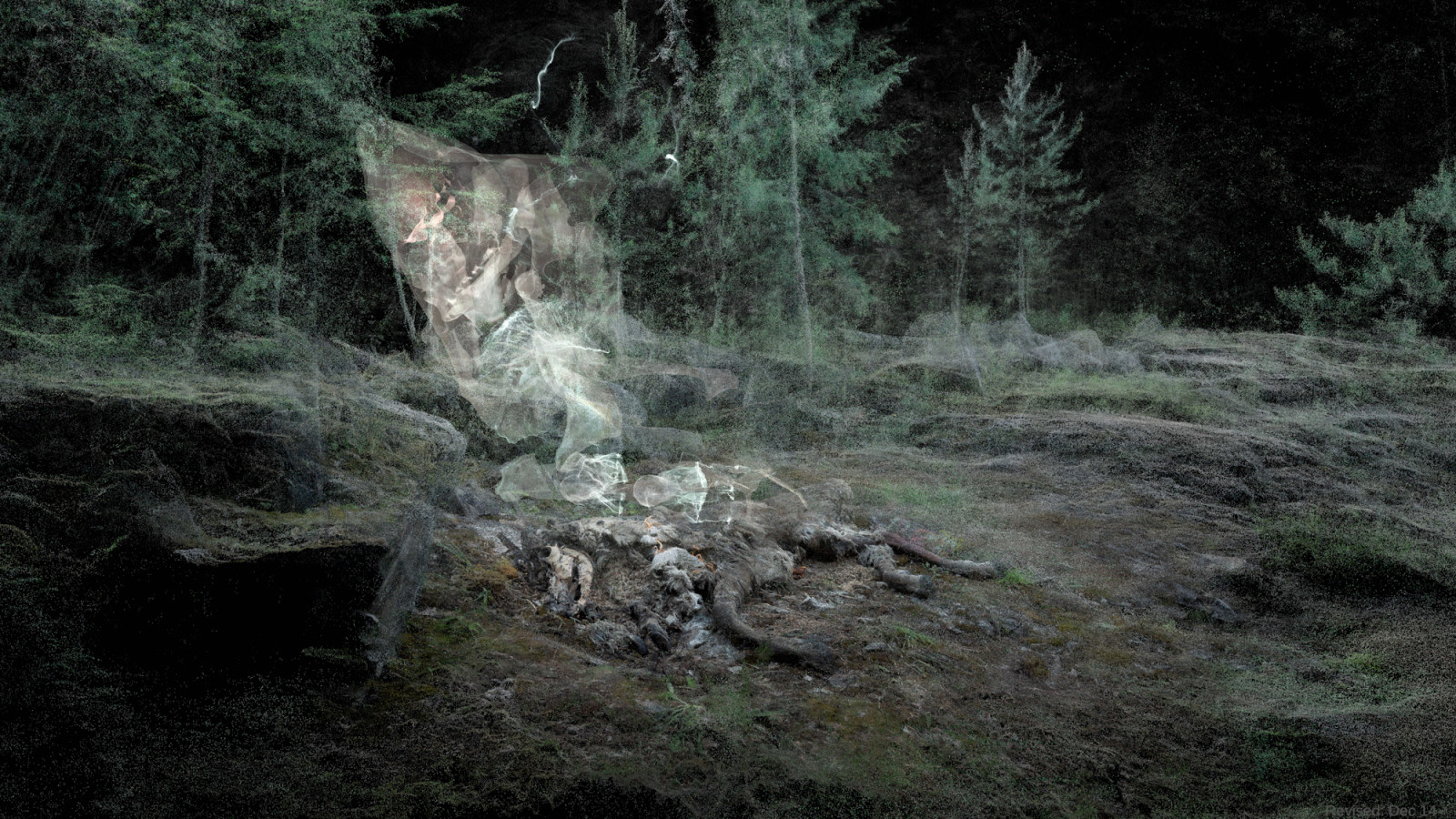
| Pierre Huyghe, Second Law, 2021, 3D Scanning, pointcloud visualisation and pointcloud engine by ScanLAB Projects. © the artist | |
|
Pierre Huyghe If the Swamp
Kistefos Samsmoveien 41 Jevnaker From June 12, 2022 www.kistefosmuseum.comStarting on June 12, 2022, a major new project by Pierre Huyghe will be presented at the Kistefos Museum and Sculpture Park located near the Norwegian town of Jevnaker, one hour north-west of Oslo. The site-specific new commission will be the artist's largest site-specific work to date and the most ambitious to ever be conceived for Kistefos. As the 50th artwork to be included in the park, the artwork will inaugurate a previously inaccessible area of the park extending the visitor landscape. The site, chosen by the artist, is in a regularly flooded area of the park next to the working power plant, linking Kistefos’ industrial heritage with what it has become today. Huyghe is known for his immersive artworks and continues to expand our notion of what sculptural art can be. Responding to Kistefos’ environment, If the Swamp is an entity, a milieu, both physical and digital, permeable, continuously shaped by the surrounding flood waters and modified by what it perceives. The work is simultaneously an island and the possibility of what this island could be under alternate conditions of reality. The forests entire site has been scanned, down to its details, and digitalised. In a simulated environment, unbound from physical limitations, algorithmic and biological agent intelligences cooperate. A fiction-based set of rules is played out by learning machines that continually generate mutations of existing features, such as trees, trash, animals, or humans. The mutations change behaviours in real time according to external factors, accelerating their growth with the flood water, and transforming over the years. At times they randomly exit the simulation to manifest themselves physically on the actual island. They sustain or decompose, modifying the island’s appearance and progressively contaminate the existing reality with another possibility of itself. At the far end of the forest stands a screen where an autonomous eye navigates the simulated environment, witnessing its ever-changing nature.
|
|
|
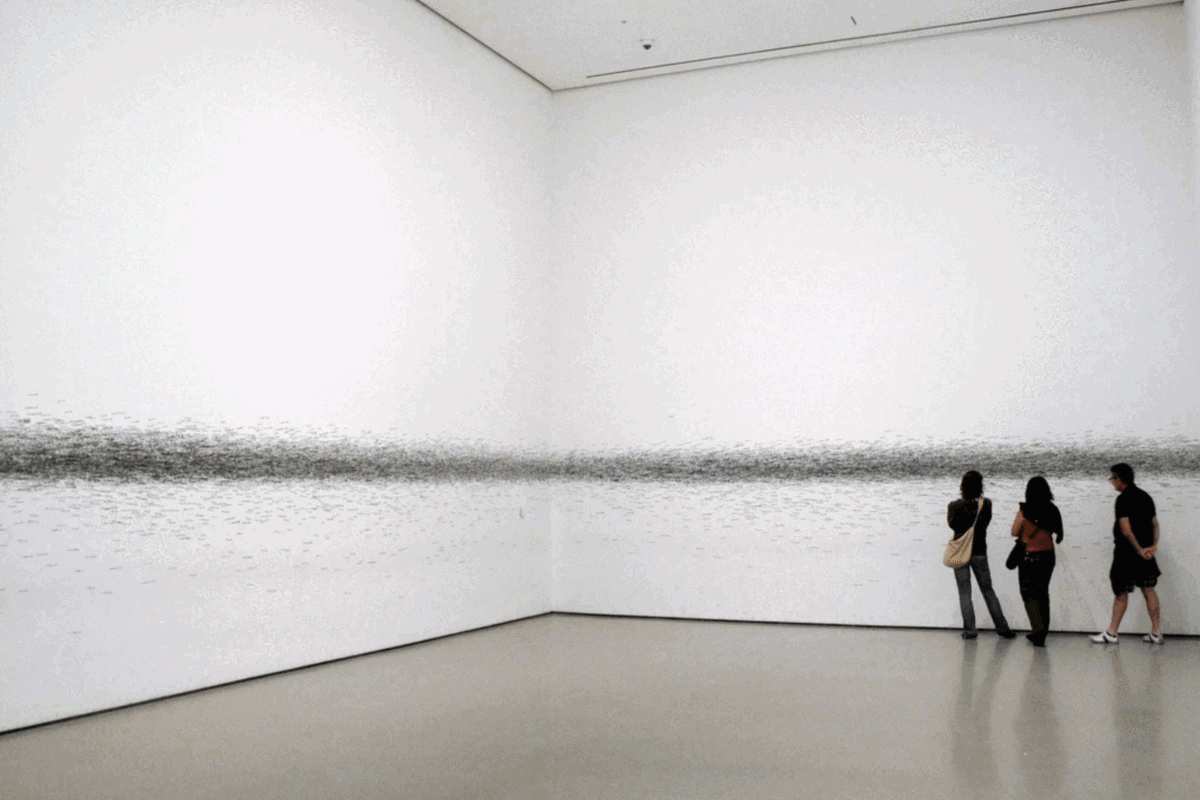
| Roman Ondak, Measuring the Universe, 2007
Performance views: MoMA, New York, 2009. Photos © MoMA | |
|
Roman Ondak Measuring the UniversePinakothek der Moderne Munich June 3 - September 25, 2022 www.pinakothek-der-moderne.deBeginning June 3, 2022, the Pinakothek der Moderne in Munich will enact Roman Ondak's Measuring the Universe. The performative work, last seen at the Pinakothek der Moderne in 2007, has since been re-enacted at major international institutions. The concept of Measuring the Universe is simple: the height of the museum visitors is recorded on the wall - in the way parents mark the growth of their children to give them a sense of the dimension of time. An everyday, actually private action becomes the center of attention and is transformed into a public and collective action. During the exhibition period, a drawing is created on the wall that becomes denser and blacker. In the end, all the people will be present at the same time, although they will all have left as well. Measuring the Universe, then, is a picture of our life in this world - a picture of the importance, but also insignificance of the individual human being in mass and time. Roman Ondak's work evolves from a performative conception and consists of sculpture, installation, photography, drawing and performance. The artist often uses found objects. His medium is the everyday and society's sets of expectations, assumptions, automatisms and projections that shape our perception of reality. His works can transform everyday rituals into poignant performative situations, obliquely addressing social and political ideas and images. Below find a video with the artist produced on occasion of the work's enactment at the Museum of Modern Art in New York in 2009.
|
|
|
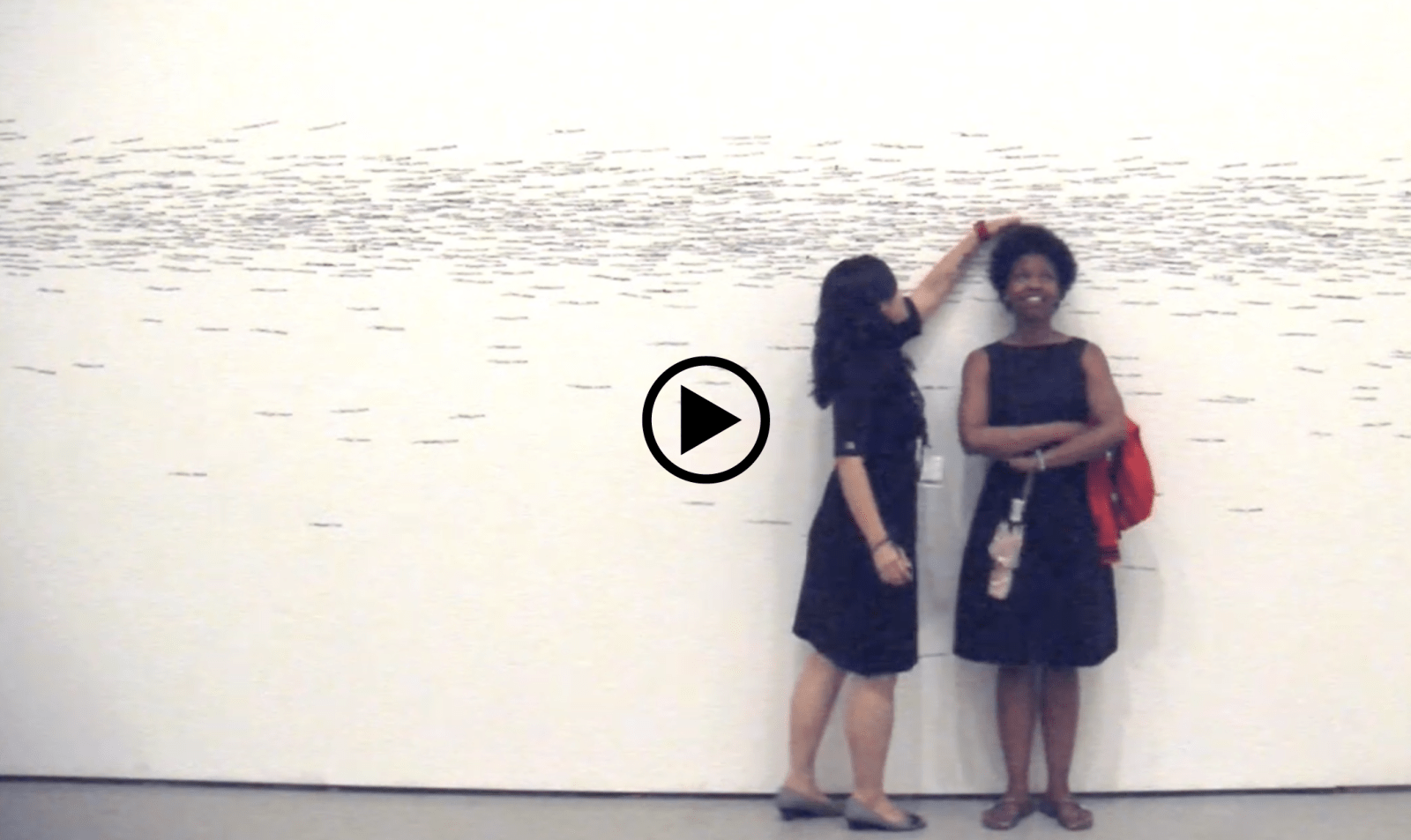
| Watch now: Roman Ondak discusses Performance 4, Measuring the Universe, at MoMA.
Still © The Museum of Modern Art, New York | |
|
Podcast with Esther Schipper
|
|

| VOICES ON ART - The VAN HORN Gallery Podcast, hosted by Daniela Steinfeld - Episode 61 with Esther Schipper Listen herePhoto © Kristian Schuller | |
|
For her VOICES ON ART - The VAN HORN Gallery Podcast, Daniela Steinfeld recently spoke with Esther Schipper.
As Daniela Steinfeld notes: "Esther talks in depth about her background, her growing up in a very cosmopolitan and culturally educated and interested household, being born and raised in Taipei and later growing up in Paris. She talks about the early days of her gallery and how she felt the need to grow and adapt in accordance with an ever changing world. Staying true to the DNA of the gallery, keeping long lasting relationships with artists and showing loyalty towards their ideas over the years she also developed strategies for her gallery becoming an globally functioning business, with specialists in every field from art history to sales to accounting, marketing and management. It is very instructive and highly interesting to follow the development of her gallery through the decades in her very own words." |
|
|
L’Invitation au voyage
With texts by Gayatri Gopinath, Karoline Hille, Matthew Hyland, Marco Livingstone, Isabelle Moffat, Tobias Peper, Andy St. Louis, Wenny Teo, Marie-Catherine Vogt, Wim Wenders, and Chung Wei-Tzu.
|
|
Rosa Barba
On the Anarchic Organization of Cinematic Spaces - Evoking Spaces Beyond Cinema
2021
Publisher: Hatje Cantz
Language: English
Available here
|
|
David Claerbout
The Silence of the Lens
2022
Publisher: Hannibal Books
Language: English, French
Available here
|
|
Angela Bulloch
Euclid In Europe
2019
Publisher: Hatje Cantz
Language: English
Available here
|
|
Roman Ondak
Fail to Fall
2021
Publisher: Slovart, Photoport
Language: English, Slovak
Available here
|
|
Roman Ondak
Measuring the Universe
2009
Publisher: JRP | Editions
Language: English
Available here
|
|
Pierre Huyghe
2019
Publisher: Serpentine Galleries, Koenig Books, Luma Foundation
Language: German, English
Available here
|
|
|
ESTHER SCHIPPER
POTSDAMER STRASSE 81E
10785 BERLIN
|
|
|
|
|
